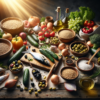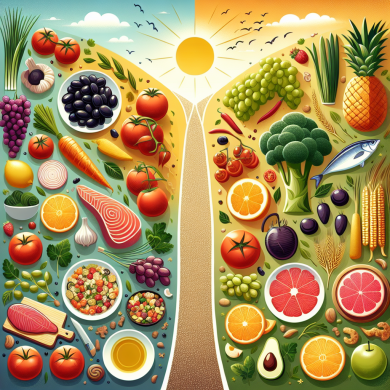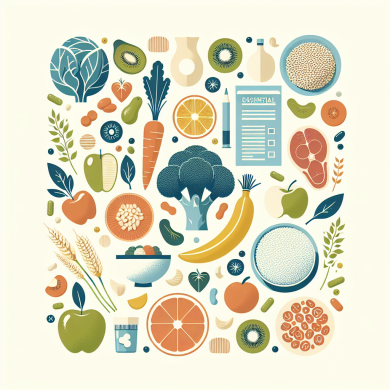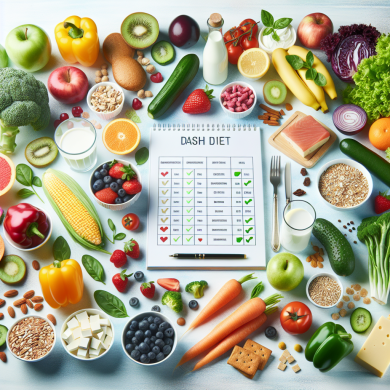DASH Diet Grocery Shopping: Essential Tips
Introduction to the DASH Diet
The Dietary Approaches to Stop Hypertension (DASH) diet is a well-researched and highly recommended eating plan designed to help control high blood pressure. This diet emphasizes the consumption of whole foods, rich in nutrients like potassium, calcium, and magnesium, which are key to maintaining healthy blood pressure levels. The DASH diet is not only beneficial for those with hypertension but also promotes overall health and well-being. Grocery shopping for the DASH diet can be straightforward with the right knowledge and strategies. This article provides essential tips to help you navigate your grocery store with confidence while adhering to the DASH diet principles.
Understanding the Basics of the DASH Diet
The DASH diet encourages the consumption of fruits, vegetables, whole grains, lean proteins, and low-fat dairy, while limiting foods high in saturated fat, cholesterol, and sodium. The diet is flexible and doesn’t require special foods but focuses on making healthier choices within each food group. This means prioritizing nutrient-dense items that naturally help to lower blood pressure and improve heart health.
Planning Your Grocery Shopping
Grocery shopping for the DASH diet starts with a solid plan. Begin by creating a weekly meal plan that incorporates a variety of foods from each recommended food group. This will not only ensure you have a balanced diet but also help prevent unnecessary purchases.
Making a Shopping List
A shopping list is an essential tool for staying focused and avoiding impulse buys. Organize your list according to the store layout, usually starting with produce and ending with frozen foods. Be sure to include fresh fruits and vegetables, whole grain products, lean protein sources, and low-fat dairy items.
Budgeting for the DASH Diet
Following the DASH diet doesn’t have to be expensive. Buying in-season fruits and vegetables, choosing store brands, and purchasing items in bulk can help keep costs down. Planning meals around sales and using coupons are also effective strategies for sticking to a budget while maintaining a healthy diet.
Essential Food Groups to Focus On
Understanding which food groups are emphasized in the DASH diet is crucial for effective grocery shopping. Here’s a breakdown of each group:
Fruits and Vegetables
The DASH diet recommends consuming 4-5 servings of both fruits and vegetables each day. Opt for fresh, frozen, or canned options without added sugars or sodium. Stock up on a colorful variety to ensure a wide range of nutrients. Leafy greens, berries, citrus fruits, and cruciferous vegetables like broccoli are particularly beneficial.
Whole Grains
Whole grains are an integral part of the DASH diet, providing fiber and essential nutrients. Look for breads, cereals, and pasta labeled as “100% whole grain” or “whole wheat.” Brown rice, quinoa, and oats are other excellent choices. Aim for 6-8 servings of whole grains daily.
Lean Proteins
Choose lean protein sources such as poultry, fish, beans, and legumes. Incorporate fish high in omega-3 fatty acids, like salmon and mackerel, into your diet at least twice a week. Plant-based proteins such as lentils, chickpeas, and tofu are also excellent options.
Low-Fat Dairy
Dairy products in the DASH diet should be low in fat to reduce saturated fat intake. Choose skim or 1% milk, low-fat yogurt, and cheeses. These provide calcium, vitamin D, and protein without the excess fat found in full-fat versions.
Nuts, Seeds, and Legumes
Nuts, seeds, and legumes are rich in protein, fiber, and healthy fats. Incorporate a few servings of these nutrient powerhouses into your weekly diet. Almonds, walnuts, flaxseeds, and lentils are all excellent choices. Be mindful of portion sizes, as nuts and seeds are calorie-dense.
Limiting Sodium and Unhealthy Fats
A key aspect of the DASH diet is reducing sodium intake and avoiding unhealthy fats. Here’s how to manage these elements while shopping:
Reading Nutrition Labels
Becoming proficient at reading nutrition labels is crucial. Look for products with low sodium content, ideally less than 140 mg per serving. Check saturated fat and trans fat levels, opting for products with minimal amounts. Ingredients are listed by quantity, so the ones at the top are present in the highest amounts.
Choosing Fresh Over Processed
Processed foods often contain high levels of sodium and unhealthy fats. Whenever possible, choose fresh, whole foods. If you must buy processed options, select those labeled as low-sodium or no added salt and fat-reduced products.
Healthy Cooking Oils
Opt for heart-healthy oils such as olive, canola, or avocado oil. These contain monounsaturated fats, which can help lower bad cholesterol levels. Avoid oils high in saturated fats like palm oil and coconut oil.
Incorporating Variety and Flavor
The DASH diet is flexible and allows for a wide variety of foods and flavors. Here are some tips for keeping your meals exciting:
Using Herbs and Spices
Enhance the flavor of your meals with herbs and spices instead of salt. Fresh herbs like basil, cilantro, and parsley add vibrant flavors. Spices like turmeric, cumin, and cinnamon can transform a dish and provide health benefits.
Exploring New Foods
Don’t shy away from trying new foods or recipes. Exploring different cuisines can introduce you to new flavors and cooking techniques. International markets often offer a variety of unique ingredients that can fit within the DASH diet guidelines.
Conclusion
Grocery shopping for the DASH diet may initially seem daunting, but with these essential tips, you can navigate the aisles with confidence. By focusing on whole foods, being mindful of sodium and unhealthy fats, and embracing variety, you’ll be well on your way to a heart-healthy lifestyle. The DASH diet is not just a short-term plan but a sustainable approach to eating that can benefit your health for years to come. Happy shopping!















Add comment